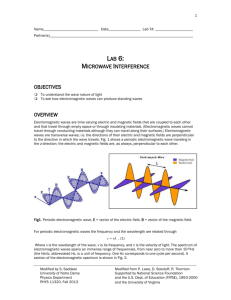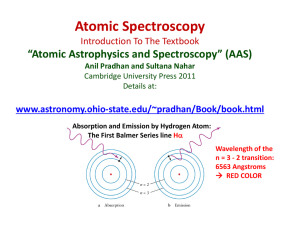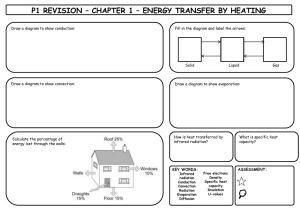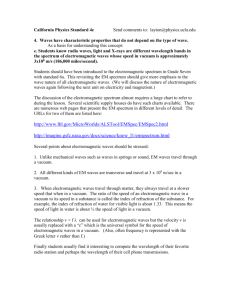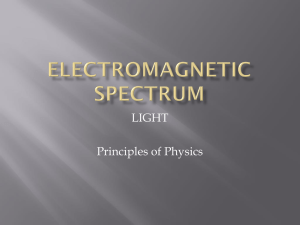Lab6.11320
advertisement
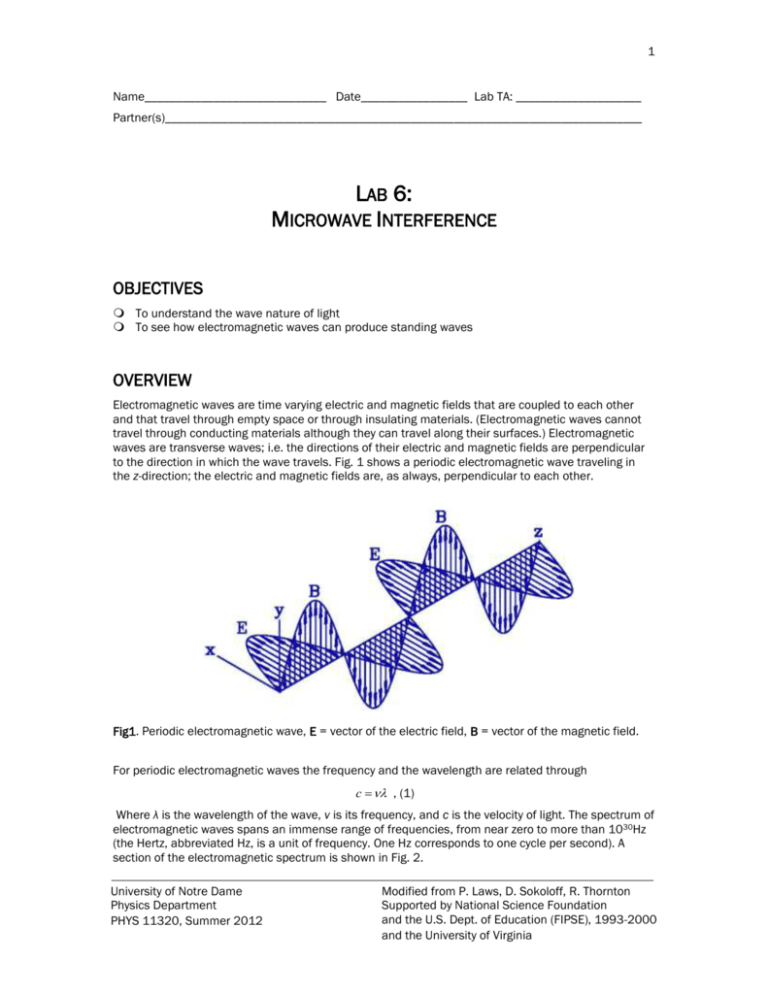
1 Name_____________________________ Date_________________ Lab TA: ____________________ Partner(s)____________________________________________________________________________ LAB 6: MICROWAVE INTERFERENCE OBJECTIVES To understand the wave nature of light To see how electromagnetic waves can produce standing waves OVERVIEW Electromagnetic waves are time varying electric and magnetic fields that are coupled to each other and that travel through empty space or through insulating materials. (Electromagnetic waves cannot travel through conducting materials although they can travel along their surfaces.) Electromagnetic waves are transverse waves; i.e. the directions of their electric and magnetic fields are perpendicular to the direction in which the wave travels. Fig. 1 shows a periodic electromagnetic wave traveling in the z-direction; the electric and magnetic fields are, as always, perpendicular to each other. Fig1. Periodic electromagnetic wave, E = vector of the electric field, B = vector of the magnetic field. For periodic electromagnetic waves the frequency and the wavelength are related through c , (1) Where λ is the wavelength of the wave, v is its frequency, and c is the velocity of light. The spectrum of electromagnetic waves spans an immense range of frequencies, from near zero to more than 1030Hz (the Hertz, abbreviated Hz, is a unit of frequency. One Hz corresponds to one cycle per second). A section of the electromagnetic spectrum is shown in Fig. 2. University of Notre Dame Physics Department PHYS 11320, Summer 2012 Modified from P. Laws, D. Sokoloff, R. Thornton Supported by National Science Foundation and the U.S. Dept. of Education (FIPSE), 1993-2000 and the University of Virginia 2 Electromagnetic waves are produced whenever electric charges are accelerated. One way to produce electromagnetic waves is by letting an alternating current flow through a wire, an antenna. The frequency of the waves created in this way equals the frequency of the alternating current. The visible light emitted by a light bulb is caused by thermal motion that accelerates the electrons in the hot filament sufficiently to produce visible light. The inverse effect also happens: if an electromagnetic wave strikes a wire, it induces an alternating current of the same frequency in the wire. This is how the receiving antennas of a radios or television sets work. As one might expect, an antenna is most efficient when its length is of the order of the wavelength of the waves emitted or received. The waves used for TV transmission have wavelengths of the order of one meter, which is also the size of a typical TV antenna. In this workshop you will be studying how electromagnetic waves interfere. We will be using a small region of the electromagnetic spectrum: microwaves. Look at Fig. 2 to understand the relative position of microwaves and visible light. The microwaves that you will be using in this experiment have a frequency of 1.05 × 1010 Hz, corresponding to a wavelength of 2.85 cm. The name microwave is to be understood historically: In the early days of radio the wavelengths in use were of the order of hundreds, even thousands, of meters. Compared with these waves, those in the cm region, which were first used in radar equipment during W.W. II, were indeed ‘micro’waves. We will begin in Investigation 1 to familiarize you with both the production and detection of microwaves. We are already familiar with them from our microwave ovens found in kitchens, dorm rooms (?), and offices everywhere. In Investigation 2 we will study standing waves, which occur surprisingly often, especially in musical instruments. In Investigation 3 we shall look at interference effects of microwaves. University of Notre Dame Physics Department PHYS 11320, Summer 2012 Modified from P. Laws, D. Sokoloff, R. Thornton Supported by National Science Foundation and the U.S. Dept. of Education (FIPSE), 1993-2000 and the University of Virginia 3 INVESTIGATION 1: POLARIZATION OF MICROWAVES For this investigation, you will need the following: PASCO Gunn diode microwave transmitter (Blue horn) PASCO microwave probe PASCO Microwave receiver (Yellow horn) one or two digital multimeters (DMMs) DC Power supply Mounts/cradles for the equipment Meter stick or tape measure, plastic ruler, protractor Fig. 3. Experimental setup. 1. Inside the microwave generator is a solid-state device called a Gunn diode. When a dc voltage is applied to a Gunn diode, current flows through it in bursts at regular intervals. For your diode, these bursts come 9.52 × 10-11 seconds apart causing, in addition to the dc current, an ac current at a frequency of 1.05 × 1010 Hz. As a result, a large ac voltage, oscillating at this frequency, is present across the diode, and a wave is radiated from the horn-like device of the generator. The electric field of this wave oscillates in the vertical direction when the knob on the back is at 0º, parallel to the Gunn diode horn. The polarization of an electromagnetic wave is determined by the direction of the electric vector. The magnetic field encircles the current in the Gunn diode and so emanates in the orientation perpendicular to the electric field (see Fig. 1). At 0º the electric field will be vertical, and the magnetic field horizontal. Locate the microwave receiver. Just inside the horn of the receiver is a detector diode much like the one on the microwave probe. In addition, there is some circuitry, which amplifies the signals received by the diode and outputs this amplified signal to a d’Arsonval meter and to an external output. The amplification, or alternatively its inverse the sensitivity (also labeled METER MULTIPLIER), is controlled via two knobs. The VARIABLE SENSITIVITY knob allows for fine adjustment. As you turn up the sensitivity (from 30 to 1), the signal is amplified more and more. It is imperative that you NOT peg the meter as doing so can damage it! If you find the meter pegged, immediately turn down the sensitivity and/or move the receiver away from the microwave generator! 2. Connect the power supply to the (orange) transmitter and the DMMs (if needed) as ammeters to the (blue) receivers. Position the transmitter and one receiver on support stands with the horns facing each other about 100 cm apart (see Figure 3). Line them up along the side of the meter stick. Turn on the receivers and/or meters and set the Pasco receivers’ meter multipliers to 30X initially. You may need to change the range for different parts of the experiment. Plug in the power supply to the transmitter. The meter for the receiver should show a good signal. Change meter ranges if necessary to get a good signal. Question 1-1: If the receiver antenna is placed in the vertical direction, in what direction should the electric field be directed to maximize the signal received by the antenna? Remember that it’s the University of Notre Dame Physics Department PHYS 11320, Summer 2012 Modified from P. Laws, D. Sokoloff, R. Thornton Supported by National Science Foundation and the U.S. Dept. of Education (FIPSE), 1993-2000 and the University of Virginia 4 incident Electric field that will be moving charges in the antenna to generate a current. The antenna is designed to be equal to the length of two wavelengths, i.e. 5.7 cm. When the electric field of the microwave strikes it, an ac voltage at a frequency 1.05 × 1010 Hz is induced across the diode. 3. Adjust the distance of the probe from the generator until the meter registers a voltage about 3/4 of full scale. (Remember to keep your hand out of the way since any conductor in the vicinity, e.g. a piece of metal, even your hand, will reflect waves and may give you spurious results.) Begin with both antennae oriented vertically. Rotate the generator and verify that the detector is sensitive to the polarization of the wave. Remember from the previous lab that the electric field is oriented along the vertical at 0º. As you rotate the generator from this angle, the detected signal should decrease. Check that this happens. Record the meter readings on the detector for the following angles of rotation of the generator: Angle (degrees) Meter Reading (V) 0 15 30 45 60 75 90 4. An E-field perpendicular to the diode should induce no voltage. (The meter may register a voltage when the generator and probe are 90º relative to each other due to the DC OFFSET of the amplifier. Normally, one would subtract this offset from all measurements.) Return the generator angle to 0º. Move the diode away from the horn. Question 1-2: Plot your data for the Voltage you measured at the different angles on the graph below. Describe the relationship between the measured voltage and the angle. What shape of curve would you expect? (Linear? Curved?) Why? University of Notre Dame Physics Department PHYS 11320, Summer 2012 Modified from P. Laws, D. Sokoloff, R. Thornton Supported by National Science Foundation and the U.S. Dept. of Education (FIPSE), 1993-2000 and the University of Virginia 5 Voltage 15 30 45 60 75 90 angle INVESTIGATION 2: STANDING WAVES When waves moving in a given medium have the same frequency, it is possible for the waves to interfere and form a stationary pattern called a standing wave. These waves, though they are not found in all waves, do occur in a variety of situations, most commonly perhaps in waves on a string, like in a guitar or violin. It might be worthwhile for the student to review material on standing waves in a string fixed at both ends. The incident and reflected waves combine according to the superposition principle and can produce a standing wave. Similar behavior occurs for electromagnetic waves, but what is waving is, of course, much different. It is not so easy to imagine something physical waving, because in the case of electromagnetic waves, it is the electric (and magnetic) fields that are oscillating, and no medium is required. Electromagnetic waves travel most easily in a vacuum. The study of electromagnetic radiation propagation and reflection from metal plates is beyond the scope of our course, but suffice it to say that when the electric field reaches a metal plate, it will induce a large current in the metal. This current will then reradiate an electric field of its own, i.e. the reflected electric field. The reradiated field must exactly cancel the incoming field within the metal, for any finite electric field would produce an infinite current within the zero resistance of the metal. The reradiated or reflected electric field will therefore have the same frequency and wavelength of the incident electric field. At certain distances along the path, the two fields will constructively interfere and produce a maximum signal in the detector probe, while at other locations they will destructively interfere and produce a minimum signal. This will occur, for example, between the detector and reflector in Fig. 4, which we will next investigate. The incoming field from the generator will be reflected from the metal plate and subsequently interfere with the incident wave. Certain positions of the reflector will therefore cause maximum and minimum voltages in the detector probe. We can use the positions of these maxima and minima to determine the wavelength of the electromagnetic field. It is useful to keep in mind the case of the taut string at both ends, although the physical process taking place is quite different with electromagnetic fields. For this investigation, you will need the following materials: PASCO Gunn diode microwave transmitter PASCO microwave probe University of Notre Dame Physics Department PHYS 11320, Summer 2012 Modified from P. Laws, D. Sokoloff, R. Thornton Supported by National Science Foundation and the U.S. Dept. of Education (FIPSE), 1993-2000 and the University of Virginia 6 Metal reflector plate Component holders Meter stick or tape measure, plastic ruler Prediction 2-1: If we place a reflector behind the detector probe, the microwave should be reflected back towards the generator. What do you think will happen to the original wave and the reflected wave? What are the conditions to produce a maximum constructive standing wave? What are the conditions to produce a minimum? 1. Set up the microwave detector 50 cm from the generator. Make sure that the detector is in the same plane as the horn on the microwave generator (or you will get no signal). Place a reflector (solid flat piece of metal) behind the detector probe, as shown in Fig. 4. This will produce a standing wave between the generator and the reflector. Making sure to keep the probe at least 50 cm from the generator, slide the probe along the meter stick, and notice there are positions of maxima and minima signal strength. Slide the detector probe along the meter stick, no more than a cm or two, until you determine a maximum signal. Then slide the reflector, again no more than a cm or two, until you obtain another maximum signal strength. Continue making slight adjustments to the detector probe and reflector until the meter reading is as high as possible, but not pegging the meter. If this occurs, move the generator back further away. Fig. 4. Reflector placed by the probe detector. 2. Now find a node (minimum) of the standing wave pattern by slightly moving the probe until the meter reading is a minimum. We want to determine the wavelength of the standing wave, so only relative distances between maxima and/or minima are relevant. In this case, it is easiest to use the meter stick and measure the distance using the probe base. Record the position of the probe below: Initial probe position at minimum: ____________________ 9. While watching the meter, slide the probe along the meter stick until the probe has passed through at least 10 antinodes (maxima) and returned to a node. Be sure to count the number of antinodes that University of Notre Dame Physics Department PHYS 11320, Summer 2012 Modified from P. Laws, D. Sokoloff, R. Thornton Supported by National Science Foundation and the U.S. Dept. of Education (FIPSE), 1993-2000 and the University of Virginia 7 were traversed. Record the number of antinodes traversed and the new probe position. Antinodes traversed: ______ Final probe position at minimum: ________ Question 2-1: What are the analogies with the nodes and antinodes found here and for the standing waves found from an oscillating string fixed at both ends (guitar). Sketch a picture. Question 2-2: What is the distance in terms of the wavelength between adjacent antinodes (maxima)? Question 2-3: What is the wavelength you deduce from your data? Wavelength of standing wave: ________________________ Question 2-4: Using this experimental wavelength value, determine the frequency of the wave. Is this consistent with your apparatus? If not, please explain. Wave frequency: ____________ INVESTIGATION 3: FURTHER EXAMPLES OF INTERFERENCE To further observe interference with microwaves, you will need the following: PASCO Gunn diode microwave transmitter PASCO microwave receiver Double slit hood Meter stick or tape measure, plastic ruler, protractor University of Notre Dame Physics Department PHYS 11320, Summer 2012 Modified from P. Laws, D. Sokoloff, R. Thornton Supported by National Science Foundation and the U.S. Dept. of Education (FIPSE), 1993-2000 and the University of Virginia 8 Fig. 5. Microwave generator and receiver arrangement. CAUTION: DO NOT ALLOW THE RECEIVER’S METER TO PEG AT ANY TIME! 1. Replace the detector probe and reflector with the receiver, as shown in Fig. 5. Set the knob on the back of the receiver to 0º. Starting with the meter multiplier on 30, adjust the sensitivity to obtain a signal near 0.5 on the meter. If you cannot achieve this with a sensitivity of 10 or 3, move the receiver closer to the generator. Activity 3-1: Two Slit Interference 1. Slide the double slit hood over the generator’s horn, creating two coherent microwave sources as shown in Fig. 6. 2. Place the generator such that the hood lies directly over the protractor (at the center of the circle). Place the receiver on the meter stick so that the horns are about 25 cm apart. Use the edge of the meter stick to measure the angles through which the detector will be rotated. The signal amplitude that the receiver will detect depends on the phase of the microwaves when they reach the receiver probe. To a good approximation, if x = d sin is equal to an integral number of wavelengths nλ, then the microwaves from the two slits will interfere constructively and you will see a maximum register on the meter. Likewise, if d sin is equal to a halfintegral number of wavelengths (n-½) , the meter will register a minimum. constructive interference: n=d sin destructive interference: (n-½)=d sin d = distance between centers of slits (double slit hood):__________ Fig. 6. Interference from the two slit hood. 3. Set the receiver to 0º. Adjust the horn around 0º to obtain a maxima signal. Then move the horn receiver to greater angles and note further maxima and minima. You will need to University of Notre Dame Physics Department PHYS 11320, Summer 2012 Modified from P. Laws, D. Sokoloff, R. Thornton Supported by National Science Foundation and the U.S. Dept. of Education (FIPSE), 1993-2000 and the University of Virginia 9 increase the sensitivity to find the minima accurately. However, reduce the sensitivity as you move away from the minima so that you do not peg the meter! You should be able to locate two minima and one other maximum on each side of the central maximum, but just look on one side of the central maximum (0º). (Hint: It is easier to slide the receiver if you place a sheet of paper under its feet.) Angles of maxima: _____________ ______________ Angles of minima: _____________ ______________ 4. Use your data for the first non-central maxima to find the wavelength. Show your calculations below. Wavelength value: _________________ 5. Use your data for the first minima to find the wavelength. Show your calculations below. Wavelength value: __________________ Question 3-1: How do your values compare with the microwave wavelength? Discuss any errors/uncertainties. 6. Unplug the DC power supply from the receptacle and turn off the receiver. University of Notre Dame Physics Department PHYS 11320, Summer 2012 Modified from P. Laws, D. Sokoloff, R. Thornton Supported by National Science Foundation and the U.S. Dept. of Education (FIPSE), 1993-2000 and the University of Virginia 10 University of Notre Dame Physics Department PHYS 11320, Summer 2012 Modified from P. Laws, D. Sokoloff, R. Thornton Supported by National Science Foundation and the U.S. Dept. of Education (FIPSE), 1993-2000 and the University of Virginia 11 University of Notre Dame Physics Department PHYS 11320, Summer 2012 Modified from P. Laws, D. Sokoloff, R. Thornton Supported by National Science Foundation and the U.S. Dept. of Education (FIPSE), 1993-2000 and the University of Virginia 12 Regions of the Electromagnetic Spectrum The following table gives approximate wavelengths, frequencies, and energies for selected regions of the electromagnetic spectrum. Spectrum of Electromagnetic Radiation Region Wavelength (Angstroms) Wavelength (centimeters) Frequency (Hz) Energy (eV) Radio > 109 > 10 < 3 x 109 < 10-5 Microwave 109 - 106 10 - 0.01 3 x 109 - 3 x 1012 10-5 0.01 Infrared 106 - 7000 0.01 - 7 x 10-5 3 x 1012 - 4.3 x 1014 0.01 - 2 Visible 7000 - 4000 4.3 x 1014 - 7.5 x 1014 2-3 Ultraviolet 4000 - 10 4 x 10-5 - 10-7 7.5 x 1014 - 3 x 1017 3 - 103 X-Rays 10 - 0.1 10-7 - 10-9 3 x 1017 - 3 x 1019 103 - 105 Gamma Rays < 0.1 < 10-9 > 3 x 1019 > 105 7 x 10-5 - 4 x 105 The notation "eV" stands for electron-volts, a common unit of energy measure in atomic physics. A graphical representation of the electromagnetic spectrum is shown in the figure below. University of Notre Dame Physics Department PHYS 11320, Summer 2012 Modified from P. Laws, D. Sokoloff, R. Thornton Supported by National Science Foundation and the U.S. Dept. of Education (FIPSE), 1993-2000 and the University of Virginia 13 The Spectrum of Visible Light The visible part of the spectrum may be further subdivided according to color, with red at the long wavelength end and violet at the short wavelength end, as illustrated (schematically) in the following figure. The visible spectrum University of Notre Dame Physics Department PHYS 11320, Summer 2012 Modified from P. Laws, D. Sokoloff, R. Thornton Supported by National Science Foundation and the U.S. Dept. of Education (FIPSE), 1993-2000 and the University of Virginia


